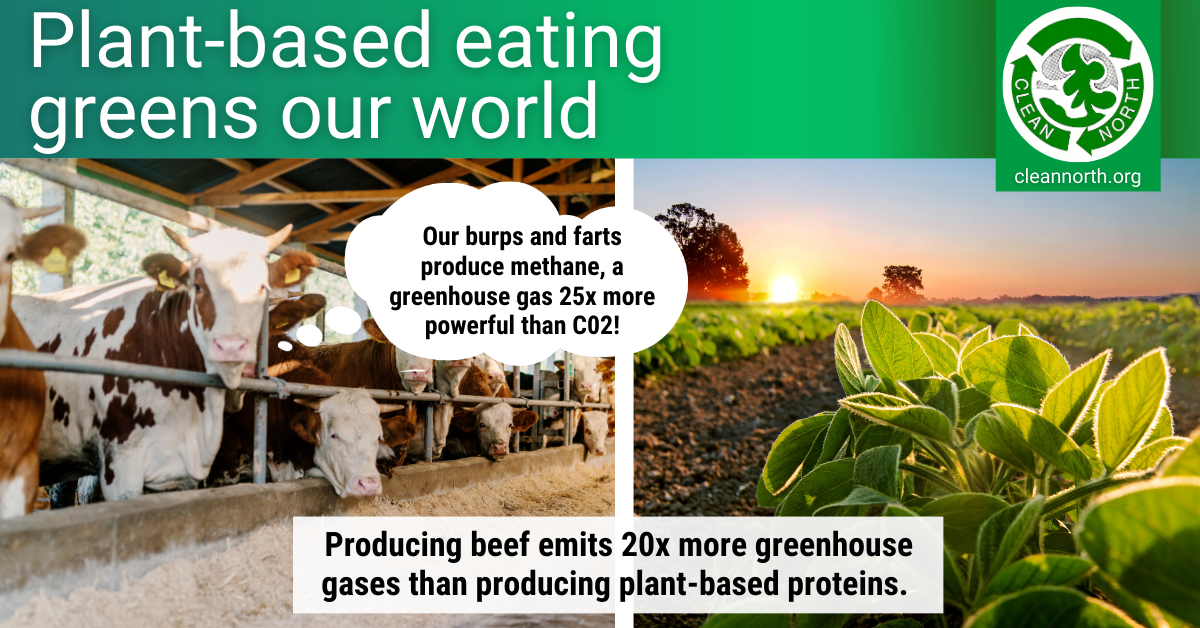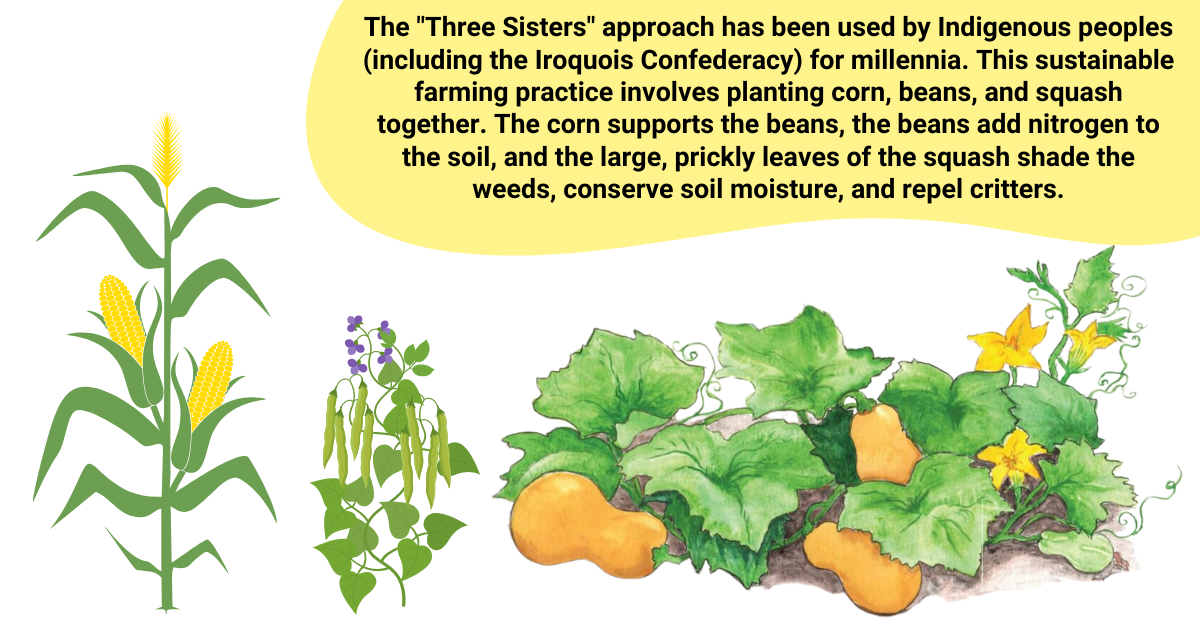
UPDATE (July 2023): New research findings from the United Kingdom show that eating a vegan diet results in 75% less climate-heating emissions, water pollution, and land use than diets involving eating 100 g of meat per day. Vegan diets were also found to cut wildlife destruction by 66% and water use by 54%. To end the climate crisis, we in rich nations must slash our meat consumption. The research also showed that what we eat is far more important than where/how it was produced. The lowest impact meat (organic pork) causes 8 times more climate damage than the highest-impact plant (oilseed). Read more
Switching from meat to plant protein (nuts, beans, lentils, chickpeas, edamame) is a top way each of us can fight climate change, says Emma Meadows, a climate scientist at Science North. During a recent spring 2023 Sault Climate Hub webinar, she shared these astounding statistics: Plant-based eating can slash your carbon footprint by up to 50%. Going meatless once a week reduces emissions as much as not driving for a whole month. If you skip beef once a week for one year, that saves the amount of emissions from driving a car over 500 kilometres. WOW! That’s compelling evidence for switching to plant-based eating—that is, if we truly want to save the planet from climate change. So much to gain from eating less meat—and so much we could lose if we do not address the climate change elephant in the room.
So what’s the beef with meat?
- Agriculture is the fifth largest source of greenhouse gases in Canada (10%), and livestock production is responsible for close to half of agricultural emissions.
- Close to half of livestock production emissions is emitted as methane, a greenhouse gas that is 25 times more powerful than carbon dioxide. Nearly one third of the world’s human-caused methane emissions are from livestock.
- Beef production is by far the worst culprit. Producing beef emits 20 times more greenhouse gases than producing plant-based proteins.
- Livestock production takes a LOT of resources: 40% of Earth’s land goes to food production, and 80% of that is used for agriculture. Agriculture uses more freshwater resources than any other human activity, and livestock production takes a big chunk of these resources. Producing one serving of beef takes many times more land and water than producing a serving of beans. It takes up to 3,000 litres of water to produce a single burger.
How does livestock production harm the environment?
Emma explains that most land being lost to development is going towards expanding farming. And satisfying our insatiable appetite for meat is causing ongoing destruction of biodiverse ecosystems, especially tropical rain forests. Since 2018, the rate of Amazon deforestation has more than doubled, and 80% of forest removal is to provide grazing land for beef cattle.
In addition to the double-greenhouse-gas whammy of removing trees and producing more methane-spewing cows, expanding industrial farming causes other environmental harms, such as more use of chemical fertilizers and pesticides, more water use, and more waste produced.
How to start reducing meat eating
“Not everyone needs to cut out all meat tomorrow,” Emma emphasizes. “You can participate in Meatless Mondays, try to go meatless for more days in the week, try to reduce food waste in your home, eat food that is produced locally, eat food that is in season, and choose sustainably sourced meat. All of those steps will help reduce emissions associated with food production.”
She made special mention of reducing food waste as Canada is one of the most food-wasting nations on Earth. Read more on the Love Food Hate Waste website
And here’s the kicker when it comes to plant-based eating: Doing what’s healthy for the environment also generally makes us healthier. Emma says that the health benefits of switching to plant proteins can include:
- Improved heart and kidney health
- Reduced risk of diseases like diabetes, heart disease, and obesity
- Reduced cholesterol and blood pressure and improved gut health
- Increased intake of fibre, potassium, and vitamin C
- Reduced risk of some cancers (pancreatic, colon, stomach, prostate)
Public health can also benefit from less demand for meat. Factory livestock farms release air pollutants like ammonia, hydrogen sulfide, methane, and particulates, leading to health issues like asthma, bronchitis, and pneumonia. And E. coli and other pathogens found in the intestines of livestock can sometimes travel to nearby vegetable farms, contaminating their water sources and the vegetables.
Emma says she switched to plant-based eating for other reasons as well, including that she has moral concerns about how animals are treated in the meat industry, especially in factory farms, that meat is expensive, that plant-based meals are more enjoyable, and that plant protein is more convenient (doesn’t have to be thawed).
Some common moral concerns about industrial livestock farming:
- Animals on factory farms are often treated inhumanely, including spending their lives stuck in large sheds in tight quarters, with little room to move around or exercise and no access to sunlight or fresh air.
- Being packed like sardines can lead to health issues: The air quality is often poor, with high levels of ammonia and other gases that can cause respiratory and other conditions. And these conditions favour the rapid spread of diseases. As a result, animals are often regularly dosed with antibiotics to prevent the spread of disease, leading in turn to antibiotic-resistant bacteria, with harm to people as well as animals.
Moving towards sustainable agriculture
If you choose to keep eating meat, at least try to source it from sustainable farms, Emma recommends. And we should all push companies and government for more sustainable agriculture because climate change and the other environmental harms of industrial farming threaten global food security and well, humanity itself.
Producing less meat and more plant-based protein will better equip us to feed everyone while reducing conflict and wars as well as strain on resources like land and water.
So what does sustainable agriculture look like? It aims to produce food in ways that enhance rather than harm the environment. For example, regenerative agriculture aims to improve soil health, increase biodiversity, and enhance ecosystem services while improving farmers’ livelihoods and contributing to food security. Tactics include minimizing soil disturbance, promoting soil health through practices like cover cropping and crop rotation, reducing or stopping use of synthetic fertilizers and pesticides, and promoting agroforestry and other diversified land uses. These practices are generally more climate-friendly.
Emma notes that Indigenous peoples have been practicing regenerative agriculture for centuries, long before the term was coined. These practices often incorporate a deep understanding of local ecosystems and their natural cycles, as well as traditional knowledge and cultural practices that have been passed down through generations.

For example, Indigenous peoples in North America have long practiced the “three sisters” approach, which involves growing corn, beans, and squash together to benefit all three crops and promote soil health. In South America, Indigenous peoples developed agroforestry systems that combine crops and trees to promote soil fertility and biodiversity.
“But I don’t know anything about cooking vegetarian/vegan meals!”
The Internet has a wealth of plant-based recipes available. You can also use the AI tool ChatGPT to generate plant-based alternatives. For example, you can ask for ChatGPT to write you a recipe for a plant-based alternative to a traditional lasagne recipe.
Below is a ChatGPT-generated plant-based recipe that one of our volunteers shared.
Moroccan Stew Risotto
1 cup arborio rice
4 cups chicken or vegetable broth
1 shallot, chopped
3 garlic cloves, minced
1 teaspoon cumin
1 teaspoon paprika
1 teaspoon cinnamon
1/2 teaspoon turmeric
1/2 teaspoon ginger
1/4 teaspoon cayenne pepper
1 can (14.5 oz) diced tomatoes
1 can (15 oz) chickpeas, drained and rinsed
1/2 cup raisins
1/2 cup sliced almonds, toasted
2 tablespoons olive oil
Salt and pepper to taste
Fresh parsley or cilantro, chopped for garnish
- In a large saucepan, heat the olive oil over medium heat. Add the onion and garlic and sauté for 2-3 minutes until they are soft and fragrant.
- Add the cumin, paprika, cinnamon, turmeric, ginger, and cayenne pepper to the saucepan and stir well to combine. Cook for 1-2 minutes until fragrant.
- Add the diced tomatoes, chickpeas, and raisins to the saucepan and stir well. Bring the mixture to a simmer and let it cook for 10-15 minutes until the vegetables are tender and the sauce has thickened.
- In a separate pot, heat the chicken or vegetable broth until it comes to a simmer.
- Add the arborio rice to the saucepan with the vegetables and stir well. Toast the rice in the vegetable mixture for 1-2 minutes, stirring constantly.
- Begin adding the simmering broth to the rice mixture one ladleful at a time, stirring constantly and allowing the rice to absorb the broth before adding more. Continue this process until the rice is tender and the mixture is creamy, about 20-25 minutes.
- Season the risotto with salt and pepper to taste. Serve hot, topped with sliced almonds and fresh parsley or cilantro.




